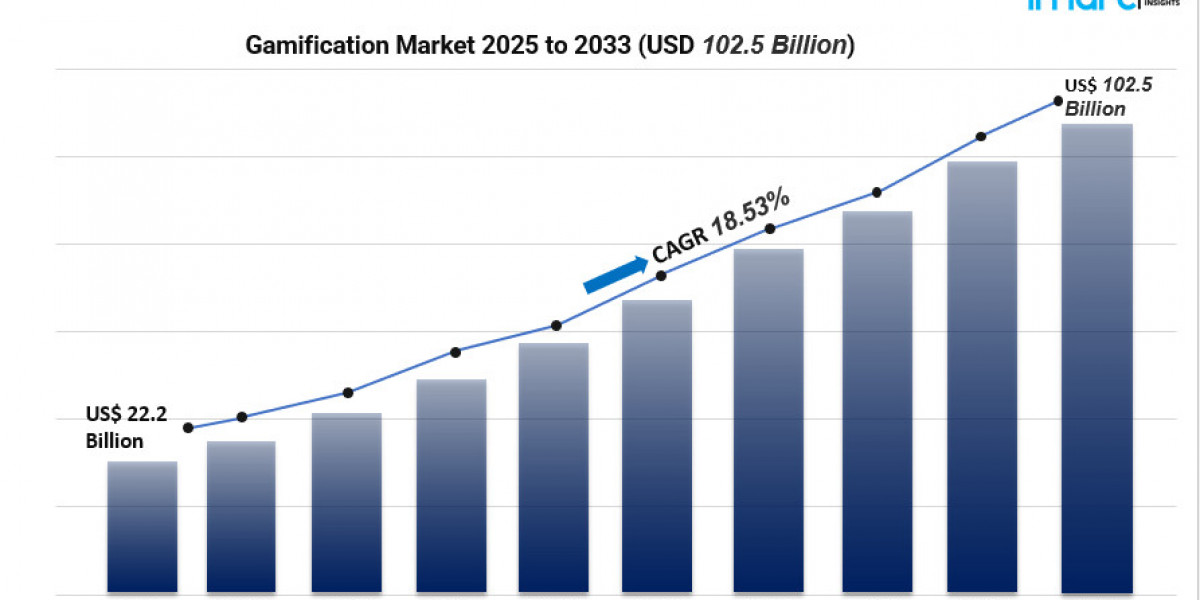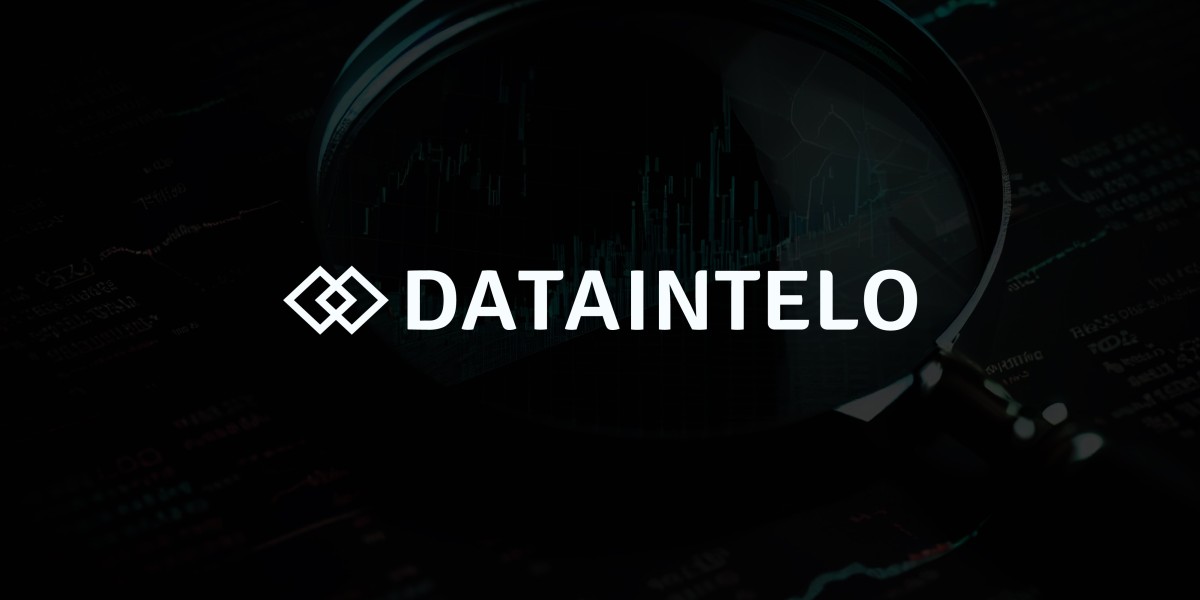MARKET OVERVIEW
The global gamification market was valued at USD 22.2 billion in 2024 and is projected to expand rapidly as organizations adopt game-based mechanics to boost engagement, training, and customer loyalty. Growing mobile use, AI/VR integration and cloud platforms are accelerating adoption across education, healthcare, retail and finance, driving stronger retention, productivity and measurable outcomes through rewards, leaderboards and interactive learning.
STUDY ASSUMPTION YEARS
- BASE YEAR: 2024.
- HISTORICAL YEAR: 2019–2024.
- FORECAST YEAR: 2025–2033.
GAMIFICATION MARKET — KEY TAKEAWAYS
- Global market size was USD 22.2 Billion (2024) with forecast to reach USD 102.5 Billion by 2033 at a CAGR of 18.53% (2025–2033).
- North America is the largest region, holding over 36.7% market share in 2024.
- Solutions (vs. services) lead the market, driven by employee training, loyalty programs and customer‑facing applications.
- On‑cloud deployment leads due to scalability, lower upfront cost and faster time‑to‑value.
- Retail is the top vertical (~27.8% share in 2024), using gamified loyalty and AR/interactive shopping features.
MARKET GROWTH FACTORS
1) Technological advancements and immersion (AI, VR/AR, mobile)
Advancements in AI, AR/VR, and ever-present mobile platforms are revolutionizing gamification, moving beyond basic point-and-badge systems to create personalized, immersive experiences. With AI-driven personalization, user behavior is analyzed to customize challenges, rewards, and learning paths, making them more relevant and boosting long-term engagement. AR and VR offer experiential simulations for training—especially in healthcare and enterprise learning—where realistic scenarios enhance skills retention and build confidence without the risks of real-world practice. Mobile apps broaden the reach and frequency of interactions, allowing users to engage in micro-learning and loyalty tasks whenever they want. These technologies also provide richer analytics, enabling organizations to assess engagement, learnability, and ROI; this data loop fosters ongoing optimization of gamified modules. The blend of scalable cloud delivery with these innovations minimizes implementation hurdles and broadens use cases across various sectors, speeding up adoption by both enterprises and consumers.
2) Industry demand and vertical expansion (corporate training, healthcare, finance, retail)
The demand across sectors is a key driver of growth as businesses in all industries focus on engagement and outcomes. Corporations are utilizing gamified training to enhance employee skills, increase productivity, and improve onboarding effectiveness; gamification taps into intrinsic motivation and provides measurable progress metrics. In healthcare, gamified apps and wearables are used to promote adherence, rehabilitation, and preventive behaviors—boosting patient engagement and outcomes while facilitating remote care. The finance and fintech sectors incorporate gamification to improve financial literacy and streamline customer onboarding, making complex concepts easier to grasp through simulations and progress tracking. Retailers are leveraging gamified loyalty programs, interactive shopping experiences, and AR try-ons to strengthen customer relationships and enhance lifetime value. This cross-sector adoption broadens the total addressable market and encourages vendors to create tailored solutions, partnerships, and bundled services that tackle specific industry challenges, driving sustained growth.
3) Deployment models, scalability and business economics (cloud adoption & enterprise dynamics)
The move towards cloud deployment has really opened up gamification for organizations of all sizes. It’s made things more affordable with lower upfront costs, introduced subscription pricing, and allowed for quick setups. Cloud models are great because they can handle varying user loads, offer smooth updates, and easily integrate with existing LMS, CRM, and HR systems. This not only cuts down on total cost of ownership (TCO) but also speeds up the time it takes to see results. Big companies are still pouring money into creating complex, tailored gamified platforms for engaging their workforce and customers, while smaller businesses are leaning towards simpler, plug-and-play cloud solutions that deliver value without needing a hefty IT budget. Plus, modern cloud offerings come with better security, analytics, and compliance features, which really help ease enterprise concerns and promote wider adoption. All in all, the combination of scalable cloud economics and the demand for measurable engagement solutions is pushing market growth and inspiring innovation among vendors.
Request for a sample copy of this report: https://www.imarcgroup.com/gamification-market/requestsample
MARKET SEGMENTATION
Analysis by Component
- Solution — Software products and platforms that embed game mechanics (badges, leaderboards, challenges) to drive engagement across training, loyalty and user interaction scenarios for enterprises and consumers.
- Service — Professional and managed services including implementation, customization, consulting, integration and support to deploy, tailor and operate gamification solutions across industries.
Analysis by Deployment Mode
- On‑premises — Locally hosted gamification platforms maintained within the enterprise environment, offering tighter control over data, customization and integration with internal systems.
- On‑Cloud — Cloud-hosted gamification solutions providing scalability, subscription pricing, rapid deployment and seamless updates, favored for cost-efficiency and easier integration.
Analysis by Enterprise Size
- Small and Medium‑sized Enterprises — SMEs adopting cost-effective, cloud-based gamified tools for training, marketing and customer engagement to improve retention without large CAPEX.
- Large Enterprises — Corporations investing in comprehensive, custom gamification initiatives for employee learning, performance management and customer loyalty at scale.
Analysis by Industry Vertical
- BFSI — Banking and financial services using gamification for onboarding, financial education, product adoption and customer loyalty programs.
- Retail — Retailers employing gamified loyalty programs, interactive shopping and AR to enhance customer engagement and repeat purchases.
- Education — E‑learning platforms and institutions integrating game mechanics to boost student motivation, retention and outcomes.
- IT and Telecom — Telecom and IT firms using gamification for customer service, sales incentives, troubleshooting and employee training modules.
- Manufacturing — Manufacturers leveraging gamified training and safety programs to upskill employees and improve operational adherence.
- Media and Entertainment — Content platforms using gamified features to increase consumption, loyalty and interactive experiences for audiences.
- Others — Additional sectors adopting gamification for specialized use cases like public health campaigns, HR, and employee engagement initiatives.
Breakup by Region
• North America (United States, Canada)
• Asia Pacific (China, Japan, India, South Korea, Australia, Indonesia, Others)
• Europe (Germany, France, United Kingdom, Italy, Spain, Russia, Others)
• Latin America (Brazil, Mexico, Others)
• Middle East and Africa
REGIONAL INSIGHTS
North America is leading the gamification market, holding over 36.7% of the share in 2024. This is largely due to a tech-savvy ecosystem, significant enterprise investment, and the rapid embrace of cloud, AI/VR, and mobile platforms. The widespread use of gamification across sectors like education, healthcare, retail, and finance is creating an environment ripe for innovation, speeding up product development and large-scale rollouts.
RECENT DEVELOPMENTS & NEWS
Recent updates showcase innovation across various industries: think blockchain and web3 wellness rewards like Universal Health Token’s Health Adventure, enhanced inflight gamified entertainment from FlightPath3D’s Kids Map, gamified public health and cessation apps, and fintech collaborations like Chime and Zogo that weave financial education into consumer apps. These examples illustrate how vendors are branching out beyond traditional training methods—integrating NFTs, token incentives, interactive passenger experiences, and behavior change applications. This evolution shows that gamification is transforming into measurable, cross-platform engagement strategies that blend blockchain, mobile, and cloud technologies to enhance user experiences and drive adoption.
KEY PLAYERS
- Ambition
- Aon PLC
- Axonify Inc.
- BI WORLDWIDE
- Cognizant
- Iactionable Inc.
- Microsoft Corporation
- MPS Limited
- NIIT Limited
- SAP SE
- Verint Systems Inc.
Ask Analyst for Customization: https://www.imarcgroup.com/request?type=report&id=5827&flag=C
If you require any specific information that is not covered currently within the scope of the report, we will provide the same as a part of the customization.
About Us:
IMARC Group is a global management consulting firm that helps the world’s most ambitious changemakers to create a lasting impact. The company provides a comprehensive suite of market entry and expansion services. IMARC offerings include a thorough market assessment, feasibility studies, company incorporation assistance, factory setup support, regulatory approvals and licensing navigation, branding, marketing and sales strategies, competitive landscape, and benchmarking analyses, pricing and cost research, and procurement research.
Contact Us:
IMARC Group
134 N 4th St. Brooklyn, NY 11249, USA
Email: sales@imarcgroup.com
Tel No: (+1-201971-6302)








